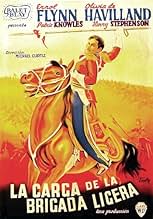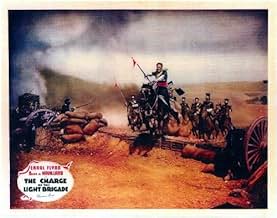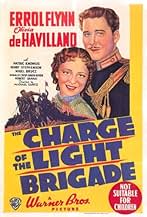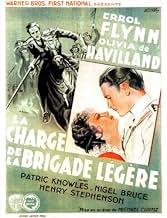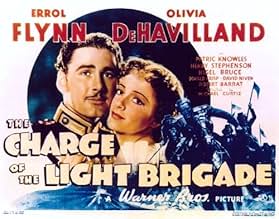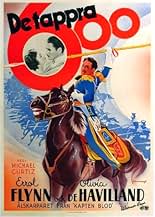CALIFICACIÓN DE IMDb
7.0/10
5.7 k
TU CALIFICACIÓN
Agrega una trama en tu idiomaA major countermands orders and attacks to avenge a previous massacre of men, women, and children.A major countermands orders and attacks to avenge a previous massacre of men, women, and children.A major countermands orders and attacks to avenge a previous massacre of men, women, and children.
- Dirección
- Guionistas
- Elenco
- Ganó 1 premio Óscar
- 4 premios ganados y 3 nominaciones en total
G.P. Huntley
- Major Jowett
- (as G. P. Huntley Jr.)
J. Carrol Naish
- Subadar-Major Puran Singh
- (as J. Carroll Naish)
Princess Baba
- Prema's Mother
- (as Princess Baigum)
Opiniones destacadas
This is Hollywood History at its best. It has nothing to do with the real Crimean War, the Battle of Balaclava, or the Charge of the Light Brigade. It has everything to do with Errol Flynn, Olivia deHavilland, Michael Curtiz, and Max Steiner. Basically, this is a quintessential Warner Bros. adventure film of 1936, one of the best of the breed.
The story starts in Southern California -- or rather, Northern India -- on the outskirts of the British Empire. This setting had been picked up and dusted off after 1935's "Lives of a Bengal Lancer", and would be recreated for "Gunga Din" a few years later, with the same locations and similar plots. Flynn leads a company of British lancers in skirmishes with the local rajah, the villainous Surat Khan -- you can tell he's the villain because of his evil goatee -- and a betrayal and a massacre leads to a mission of vengeance, which reaches its climax in Tennyson's Valley of Death in the Crimea.
Opposite Flynn is, naturally, Olivia deHavilland, without whom Flynn would be lost. Patric Knowles, who played Will Scarlett in Flynn's "Adventures of Robin Hood", is Flynn's brother; David Niven is his sidekick; and Henry Stephenson, Donald Crisp, and Nigel Bruce are the top brass. Director Michael Curtiz brings out another energetic performance from Flynn, although his character here lacks the depths of the heroes of "Captain Blood" or "The Dawn Patrol". Max Steiner's score complements the action perfectly.
"The Charge of the Light Brigade" is quite an epic production, and notorious for the number of horses killed in the battle scenes. That knowledge puts a bit of a damper on the excitement, but it also led to the safety restrictions in place today, banning trip-wires and ensuring the well-being of animals in movies; so, ultimately a good thing. No such measures were ever taken to protect history from the ravages of Hollywood screenwriters: Surat Khan and the country of Suristan never existed, nor did Flynn's 27th Lancers, and although there was indeed a charge at Balaklava, it didn't happen for the reasons depicted in this film. But Flynn and Curtiz didn't care, and neither should the audience.
The story starts in Southern California -- or rather, Northern India -- on the outskirts of the British Empire. This setting had been picked up and dusted off after 1935's "Lives of a Bengal Lancer", and would be recreated for "Gunga Din" a few years later, with the same locations and similar plots. Flynn leads a company of British lancers in skirmishes with the local rajah, the villainous Surat Khan -- you can tell he's the villain because of his evil goatee -- and a betrayal and a massacre leads to a mission of vengeance, which reaches its climax in Tennyson's Valley of Death in the Crimea.
Opposite Flynn is, naturally, Olivia deHavilland, without whom Flynn would be lost. Patric Knowles, who played Will Scarlett in Flynn's "Adventures of Robin Hood", is Flynn's brother; David Niven is his sidekick; and Henry Stephenson, Donald Crisp, and Nigel Bruce are the top brass. Director Michael Curtiz brings out another energetic performance from Flynn, although his character here lacks the depths of the heroes of "Captain Blood" or "The Dawn Patrol". Max Steiner's score complements the action perfectly.
"The Charge of the Light Brigade" is quite an epic production, and notorious for the number of horses killed in the battle scenes. That knowledge puts a bit of a damper on the excitement, but it also led to the safety restrictions in place today, banning trip-wires and ensuring the well-being of animals in movies; so, ultimately a good thing. No such measures were ever taken to protect history from the ravages of Hollywood screenwriters: Surat Khan and the country of Suristan never existed, nor did Flynn's 27th Lancers, and although there was indeed a charge at Balaklava, it didn't happen for the reasons depicted in this film. But Flynn and Curtiz didn't care, and neither should the audience.
In the mid 1930s and well into the 40s, Warner Brothers made many fine films starring Errol Flynn that were very high on production values and fun but also of dubious historical value. While historically speaking this is not the worst of the lot (that honor goes to SANTA FE TRAIL), this film doesn't seem to have a lot to do with the Tennyson poem or the Crimean War and in fact, much of the movie is set around the same region of the world as GUNGA DIN--around Pakistan or Afghanistan. So, assuming you aren't looking for a history lesson, the film is packed full of excellent acting, sets and fast-paced fun. Part of the reason I particularly liked it was because it teamed Errol Flynn with Olivia de Havilland--a wonderful combination that began with CAPTAIN BLOOD and lasted for seven films. So, if you like this film, check out all their other films together--especially CAPTAIN BLOOD and THE ADVENTURES OF ROBIN HOOD. Their chemistry was always excellent and it is further enhanced by such wonderful supporting actors as Henry Stephenson, Nigel Bruce, Donald Crisp and David Niven.
Errol Flynn, riding high with the spectacular success of CAPTAIN BLOOD, re-teamed with co-star Olivia de Havilland and director Michael Curtiz in this epic tale, owing far more to Rudyard Kipling's prose than Tennyson's poem, or any attempt at historical accuracy. As one of several 1930s Hollywood forays into India during British rule (GUNGA DIN, LIVES OF A BENGAL LANCER, and WEE WILLIE WINKIE are other memorable examples), the films are often criticized today for 'whitewashing' British rule, and ignoring the plight of Indians, who were treated as 'second-class' citizens of the Empire. While this argument is valid, these films were produced as 'entertainments' at a time when America, still suffering from the Depression, craved escapism, not social commentary.
Flynn, with his trademark moustache restored, is Major Geoffrey Vickers, dashing British Lancer, who, as the film opens, saves the life of Indian ruler Surat Khan (played by veteran screen villain C. Henry Gordon) during a tiger hunt. While Khan despises the British, he has a blood debt to Vickers, which must be honored.
Between assignments, Vickers tries to be the devoted fiancé of beautiful Elsa Campbell (de Havilland), but in a twist from the usual Flynn/de Havilland teamings, she actually loves his brother, Perry (Patric Knowles, who would later play 'Will Scarlet' in ROBIN HOOD). The love triangle subplot is the least effective part of the story; fortunately, these interludes don't last long!
Courting favor with the Russians (represented by Stalin look-alike Robert Barrat), Khan gambles, correctly, that the British would never consider him capable of murdering women and children, so his attack on an undermanned Chukoti, and the subsequent massacre of all the inhabitants (save Vickers and Campbell, thus fulfilling his blood debt), creates a furor that rocks India, and a evokes a vow of revenge from Vickers and the Lancers, who'd lost all of their loved ones. Khan flees the country, joining his Russian allies in the Crimea.
Just in time to fulfill the title, the Lancers are reassigned to the Crimea, and discover that Khan is located with the cannon emplacements on the Balaclava Heights. Arranging to get his brother safely away from the action, Vickers forges orders to have the Light Brigade attack the Heights, and 'The Charge' begins...
While the Charge (created by second unit director "Breezy" Eason) is one of the most incredible scenes ever recorded on film, with hundreds of horsemen galloping in formation 'to the guns', there was a deadly price for the spectacle; the buried explosives and trip wires used to create realistic cannon blasts injured many horses, resulting in a large number of animals having to be 'put down'. Humane societies nationwide (and Flynn, himself, who was appalled by the needless slaughter) raised such an outcry that standards were established barring cruelty to animals, which are still in effect today.
Besides Flynn's heroic performance (yes, that really IS him, leaping a cannon on horseback), Donald Crisp, Henry Stephenson, and J. Carrol Naish (as an Indian) provide memorable support. And watch for a young David Niven, as Vickers' doomed fellow officer. Flynn and Niven were great friends, sharing a cottage in Malibu (nicknamed 'Cirrhosis-by-the-Sea', because of their wild parties), and their final scene together is far more poignant than any Flynn/de Havilland moments in the film!
While flawed, historically, and unquestionably bloody, THE CHARGE OF THE LIGHT BRIGADE retains its position as a 'classic', and proved to the WB that Errol Flynn was not just a 'one hit wonder'. Great things were ahead for the young star!
Flynn, with his trademark moustache restored, is Major Geoffrey Vickers, dashing British Lancer, who, as the film opens, saves the life of Indian ruler Surat Khan (played by veteran screen villain C. Henry Gordon) during a tiger hunt. While Khan despises the British, he has a blood debt to Vickers, which must be honored.
Between assignments, Vickers tries to be the devoted fiancé of beautiful Elsa Campbell (de Havilland), but in a twist from the usual Flynn/de Havilland teamings, she actually loves his brother, Perry (Patric Knowles, who would later play 'Will Scarlet' in ROBIN HOOD). The love triangle subplot is the least effective part of the story; fortunately, these interludes don't last long!
Courting favor with the Russians (represented by Stalin look-alike Robert Barrat), Khan gambles, correctly, that the British would never consider him capable of murdering women and children, so his attack on an undermanned Chukoti, and the subsequent massacre of all the inhabitants (save Vickers and Campbell, thus fulfilling his blood debt), creates a furor that rocks India, and a evokes a vow of revenge from Vickers and the Lancers, who'd lost all of their loved ones. Khan flees the country, joining his Russian allies in the Crimea.
Just in time to fulfill the title, the Lancers are reassigned to the Crimea, and discover that Khan is located with the cannon emplacements on the Balaclava Heights. Arranging to get his brother safely away from the action, Vickers forges orders to have the Light Brigade attack the Heights, and 'The Charge' begins...
While the Charge (created by second unit director "Breezy" Eason) is one of the most incredible scenes ever recorded on film, with hundreds of horsemen galloping in formation 'to the guns', there was a deadly price for the spectacle; the buried explosives and trip wires used to create realistic cannon blasts injured many horses, resulting in a large number of animals having to be 'put down'. Humane societies nationwide (and Flynn, himself, who was appalled by the needless slaughter) raised such an outcry that standards were established barring cruelty to animals, which are still in effect today.
Besides Flynn's heroic performance (yes, that really IS him, leaping a cannon on horseback), Donald Crisp, Henry Stephenson, and J. Carrol Naish (as an Indian) provide memorable support. And watch for a young David Niven, as Vickers' doomed fellow officer. Flynn and Niven were great friends, sharing a cottage in Malibu (nicknamed 'Cirrhosis-by-the-Sea', because of their wild parties), and their final scene together is far more poignant than any Flynn/de Havilland moments in the film!
While flawed, historically, and unquestionably bloody, THE CHARGE OF THE LIGHT BRIGADE retains its position as a 'classic', and proved to the WB that Errol Flynn was not just a 'one hit wonder'. Great things were ahead for the young star!
The movie starts of as your average period drama with a love triangle and formulaic, typical '30's dramatic moments. However about halve way through the movie its story takes a turn and turns into a delicious action filled epic, with the charge of the light brigade at the ending as the icing on the cake.
I watched this film without really knowing what to expect of it. I knew Errol Flynn was in it, so I expected an adventurous movie with lots of memorable action sequence. The movie started of just like Michael Bay's "Pearl Harbor", with a love triangle story between the Errol Flynn character, his brother played by Patric Knowles and Olivia de Havilland. Flynn and de Havilland surely are one of the best screen couples of all time, so those moments are still better and more enjoyable than your average '30's love filled drama. But just like "Pearl Harbor" the best moments of the movie are in the second part, in the action sequences. The movie takes epic proportions in its action sequences, which are big and spectacularly brought to the screen. It makes the first part of the movie feel kind of obsolete and yes, it is definitely true that you can basically skip the whole first part of the movie, with the exceptions of a few sequences maybe, which are important for the development of the story and certain characters.
The story itself is quite fascinating, with the exception of the whole love triangle thing of course. It's based on true events, although the movie takes lots of liberties with the story but this really does the movie no harm. It doesn't make the actions of the light brigade seem any less noble or heroic, so the movie does the true story justice in my opinion. The several plot lines of the story are well developed in the story. I especially like the sequences with the political game between Surat Khan and the Russians with the British. There are some subtle sequences with some very well written and clever dialog. The drama in the movie is also surprisingly heavy. When you watch an Errol Flynn action flick you expect to see some lighthearted fun action sequences but in this movie the action is heavy, powerful and dramatic.
The cast is great! Errol Flynn is in his element as the popular and noble gentleman Maj. Geoffrey Vickers. Olivia de Havilland is also fine as always and it also was great to see David Niven in one of his first roles before he received real fame as an actor. It's amazing to see that he basically already looked the same in this movie as he did in movies that were made 40 years later. His role is quite small and not really significant but his presence is notable. Also really great was C. Henry Gordon as the cold-hearted villain Surat Khan, which starts of like a much warmer character. As the movie progresses he becomes more and more ruthless and he turns into almost a James Bond like villain, which works actually very well for such an adventurous action filled epic like this movie.
Based purely on all those things I just mentioned I would had rated this movie an 7 out of 10. But then came the ending...
Quite honestly, I was blown away by the ending. I simply did not expected to see such a large scale, complex action sequence in a 1936 movie. The charge in which literally hundreds of cavalry men, attack a Russian stronghold which is supported with numerous cannons is impressive to say the very least. Seeing all those hundreds of cavalry men, with Errol Flynn of course in front, riding up through the valley of death to an almost certain doom is extremely powerful. These are not CGI horses like for most part was the cast in the Lord of the Rings trilogy, this is the real thing! Horses and men flying around by the firing cannons and Errol's friends dying around him, as they come more and more closer to the Russians and Surat Khan. It such a arousing and spectacular filmed sequence that it still holds up by todays standards. Unfortunately also hundreds of horses and one stunt person got killed during the filming of the end charge. But to be honest, 1 person seems so few when you look at that sequences. I mean, men are flying and dropping from their horses like puppets, while horses ride around them within close range!
A classic epic. See this movie, if already alone for the unforgettable, arousing end charge of the light brigade.
8/10
http://bobafett1138.blogspot.com/
I watched this film without really knowing what to expect of it. I knew Errol Flynn was in it, so I expected an adventurous movie with lots of memorable action sequence. The movie started of just like Michael Bay's "Pearl Harbor", with a love triangle story between the Errol Flynn character, his brother played by Patric Knowles and Olivia de Havilland. Flynn and de Havilland surely are one of the best screen couples of all time, so those moments are still better and more enjoyable than your average '30's love filled drama. But just like "Pearl Harbor" the best moments of the movie are in the second part, in the action sequences. The movie takes epic proportions in its action sequences, which are big and spectacularly brought to the screen. It makes the first part of the movie feel kind of obsolete and yes, it is definitely true that you can basically skip the whole first part of the movie, with the exceptions of a few sequences maybe, which are important for the development of the story and certain characters.
The story itself is quite fascinating, with the exception of the whole love triangle thing of course. It's based on true events, although the movie takes lots of liberties with the story but this really does the movie no harm. It doesn't make the actions of the light brigade seem any less noble or heroic, so the movie does the true story justice in my opinion. The several plot lines of the story are well developed in the story. I especially like the sequences with the political game between Surat Khan and the Russians with the British. There are some subtle sequences with some very well written and clever dialog. The drama in the movie is also surprisingly heavy. When you watch an Errol Flynn action flick you expect to see some lighthearted fun action sequences but in this movie the action is heavy, powerful and dramatic.
The cast is great! Errol Flynn is in his element as the popular and noble gentleman Maj. Geoffrey Vickers. Olivia de Havilland is also fine as always and it also was great to see David Niven in one of his first roles before he received real fame as an actor. It's amazing to see that he basically already looked the same in this movie as he did in movies that were made 40 years later. His role is quite small and not really significant but his presence is notable. Also really great was C. Henry Gordon as the cold-hearted villain Surat Khan, which starts of like a much warmer character. As the movie progresses he becomes more and more ruthless and he turns into almost a James Bond like villain, which works actually very well for such an adventurous action filled epic like this movie.
Based purely on all those things I just mentioned I would had rated this movie an 7 out of 10. But then came the ending...
Quite honestly, I was blown away by the ending. I simply did not expected to see such a large scale, complex action sequence in a 1936 movie. The charge in which literally hundreds of cavalry men, attack a Russian stronghold which is supported with numerous cannons is impressive to say the very least. Seeing all those hundreds of cavalry men, with Errol Flynn of course in front, riding up through the valley of death to an almost certain doom is extremely powerful. These are not CGI horses like for most part was the cast in the Lord of the Rings trilogy, this is the real thing! Horses and men flying around by the firing cannons and Errol's friends dying around him, as they come more and more closer to the Russians and Surat Khan. It such a arousing and spectacular filmed sequence that it still holds up by todays standards. Unfortunately also hundreds of horses and one stunt person got killed during the filming of the end charge. But to be honest, 1 person seems so few when you look at that sequences. I mean, men are flying and dropping from their horses like puppets, while horses ride around them within close range!
A classic epic. See this movie, if already alone for the unforgettable, arousing end charge of the light brigade.
8/10
http://bobafett1138.blogspot.com/
Errol Flynn says to heck with orders and leads his men into battle against villainous Surat Khan (C. Henry Gordon) to avenge Khan's massacre of men, women, and children. Highly enjoyable adventure yarn, loosely based on historical events. Superb action scenes, fine Max Steiner score, and great Michael Curtiz direction. It's always nice to see Errol Flynn and Olivia de Havilland together, although this has the surprising twist of Olivia preferring Patric Knowles to Errol. Exceptional Warner Bros. supporting cast includes David Niven, Donald Crisp, Henry Stephenson, J. Carrol Naish, and many other familiar faces. Judging by some of the reviews here, it would appear the history police have written many tickets for this one. At the risk of incurring their terrifying wrath, I'm gonna say nerts to them! Just enjoy the movie. If you want to learn about the history behind the movie, read a book.
¿Sabías que…?
- TriviaFor the filming of the climactic charge, one hundred twenty-five horses were trip-wired. Of those, twenty-five were killed outright or had to be put down afterward. The resulting public furor caused the US Congress to pass laws to protect animals used in motion pictures. Star Errol Flynn, a horseman, was so outraged by the number of horses injured and killed during the charge, and by director Michael Curtiz's seeming indifference to the carnage, that at one point as he was arguing with Curtiz about it, he could contain himself no more and actually physically attacked him. They were pulled apart before any serious damage was done, but it put a permanent freeze on their relationship; even though they made subsequent films together, they despised each other and would speak only when necessary on the set.
- ErroresAfter the massacre, Flynn sympathetically listens to Major Singh crying over the body of his murdered son Prema who is clearly wiggling his toes in the foreground of the scene.
- Citas
[first lines]
Sir Humphrey Harcourt: How do you fellows manage to look so comfortably, Vickers?
Major Geoffrey Vickers: We may look it Sir, but we're not. They say the first forty years are about the hottest up here on the frontier, after that you get used to it.
Sir Humphrey Harcourt: Really?
- Créditos curiososOpening credits: This production has its basis in history. The historical basis, however, has been fictionized for the purposes of this picture and the names of many characters, many characters themselves, the story, incidents and institutions, are fictitious. With the exception of known historical characters, whose actual names are herein used, no identification with actual persons, living or dead, is intended or should be inferred.
- Versiones alternativasAlso available in a computer colorized version.
- ConexionesFeatured in Hollywood and the Stars: The Swashbucklers (1964)
- Bandas sonorasGod Save the Tsar
(uncredited)
Music by Alexis Lvov
[The Russian national anthem from 1833 to 1917 played as part of the score during the charge at Balaklava]
Selecciones populares
Inicia sesión para calificar y agrega a la lista de videos para obtener recomendaciones personalizadas
- How long is The Charge of the Light Brigade?Con tecnología de Alexa
Detalles
- Fecha de lanzamiento
- País de origen
- Idioma
- También se conoce como
- The Charge of the Light Brigade
- Locaciones de filmación
- Lake Sherwood, California, Estados Unidos(massacre at the boats)
- Productora
- Ver más créditos de la compañía en IMDbPro
Taquilla
- Presupuesto
- USD 1,200,000 (estimado)
- Tiempo de ejecución1 hora 55 minutos
- Color
- Mezcla de sonido
- Relación de aspecto
- 1.37 : 1
Contribuir a esta página
Sugiere una edición o agrega el contenido que falta



